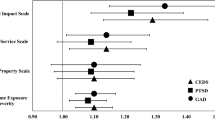Abstract
This paper examines mental health consequences of the Lockerbie Disaster in 66 adults claiming compensation from the insurers of the airline. Claimants were examined 10 to 14 months after the disaster by clinical interview and questionnaires. The most frequent diagnoses were post-traumatic stress disorder and depression, followed by other anxiety disorders. Many were above “caseness” levels on questionnaires, and had very high scores on intrusion and avoidance. There were no significant predictors of the presence or severity of diagnosis, but a number of predictors (age, death of friends, exposure to unpleasant sights) of questionnaire scores.
Similar content being viewed by others
References
Adler, A., (1943). Neuropsychiatric complications in victims of Boston's Cocoanut Grove disaster.J.A.M.A. 123: 1098–1111.
American Psychiatric Association (1987).DSM-III-R. Diagnostic and Statistical Manual of Mental Disorders (third edition, revised), APA, Washington, DC.
Bartone, P. T., Ursano, R. J., Wright, K. M., and Ingraham, L. H., (1989). The impact of a military air disaster on the health of assistance workers.J. Nerv. Ment. Dis. 177: 317–328.
Baum, A., Fleming, R., and Davidson, L. M. (1983). National disaster and technological catastrophe.Environ. Behav. 15: 333–354.
Breslau, N., and Davis, G. (1987). Posttraumatic stress disorder: The etiologic specifity of wartime stressors.Am. J. Psychiatry 144: 578–583.
Duffy, J. C., (1978). Emergency mental health services during and after a major aircraft accident.Aviat. Space Environ. Med. August: 1004–1008.
Fischer, E. F. (1991). Combat exposure and the etiology of postdischarge substance abuse problems among Vietnam veterans.J. Traum. Stress 4: 251–278.
Gibbs, M. S. (1989). Factors in the victim that mediate between disaster and psychopathology: A review.J. Traum. Stress 2: 489–514.
Goldberg, D. (1972).The Detection of Psychiatric Illness by Questionnaire Oxford University Press, London.
Goldberg, D., and Hillier, V. F. (1979). A scaled version of the General Health Questionnaire.Psychological Med. 9: 139–146.
Green, B. L. Lindy, J. D., Grace, M. C., and Gleser, G. C. (1989). Multiple diagnosis in posttraumatic stress disorder. The role of war stressors.J. Nerv. Ment. Dis. 177: 329–335.
Horowitz, M., Wilner, N., and Alvarez, W. (1979). Impact of events scale: A measure of subjective stress.Psychosom. Med. 41: 209–218.
Lima, B. R., Chavez, H., Samaniengo, N., Pompei, M. S. Pai, S., Santacruz, H., and Lozano, J. (1980). Disaster severity and emotional disturbance: Implications for primary health care in developing countries.Acta Psychiat. Scand. 79: 74–82.
Logue, J. N., Melick, M. E., and Hansen, M. (1981). Research issues and directions in the epidemiology of health effects of disasters.Epidemiol. Rev. 3: 140–162.
Maj, M., Starace, F., Crepet, P., Lobrace, G., Veltro, F., De Marcos, F., and Kemali, D. (1989). Prevalence of psychiatric disorders among subjects exposed to a national disaster.Acta Psychiat. Scand. 79: 544–549.
McFarlane, A. C. (1988a). The phenomenology of posttraumatic stress disorders following a natural disaster.J. Nerv. Ment. Dis. 176: 22–29.
McFarlane, A. C. (1988b). Relationship between psychiatric impairment and a national disaster: The role of distress.Psychological Med. 18: 129–139.
Olivero, A. A. and Fero, D. (1990). Affective disorders, DST, and treatment of PTSD patients: Clinical considerations.J. Traum. Stress 3: 407–414.
Resnick, P. J. (1988). Malingering of posttraumatic disorders. In Rogers, A. (ed.).Clinical Assessment of Malingering and Deception Guildford, London, pp. 84–104.
Snaith, R. P., Bridge, G. W. K., and Hamilton, M. (1976). The Leeds Scales for the detection of anxiety and depression.Brit. J. Psychiat. 128: 156–165.
Titchner, J. L., and Kapp, F. T. (1976). Family and character change at Buffalo Creek.Am. J. Psychiat. 133: 295–297.
Author information
Authors and Affiliations
About this article
Cite this article
Brooks, N., McKinlay, W. Mental health consequences of the Lockerbie Disaster. J Trauma Stress 5, 527–543 (1992). https://doi.org/10.1007/BF00979222
Issue Date:
DOI: https://doi.org/10.1007/BF00979222




